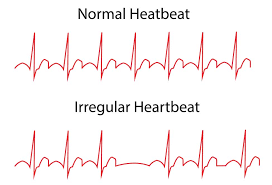Abnormal heart rhythms (arrhythmias) are sequences of heartbeats that are irregular. They are too fast, too slow, or conducted via an abnormal electrical pathway through the heart. Heart rhythms differ from one person to the other. Health, age and fitness are often key factors.
The heart is a muscular organ with four chambers, designed to work efficiently, reliably, and continuously over a lifetime. The muscular walls of each chamber contract in a regulated sequence, pumping blood as required by the body while expending as little energy as possible during each heartbeat.
Contraction of the muscle fibers within the heart is controlled by electricity. This flows through the heart in a precise manner, along distinct pathways and at a controlled speed. The electrical current that begins each heartbeat, originates in the heart’s pacemaker, located in the top of the upper right heart chamber (right atrium). The rate at which the pacemaker discharges the electrical current determines the heart rate. This rate is influenced by nerve impulses and levels of certain hormones within the bloodstream.
The heart rate is regulated automatically by the autonomic nervous system, which consists of the sympathetic and parasympathetic divisions. The sympathetic division increases the heart rate through a network of nerves called the sympathetic plexus. The parasympathetic division decreases the heart rate through a single nerve, the vagus nerve.
In an adult at rest, the heart rate is usually between sixty and one hundred beats per minute. However, lower rates may be normal in young adults, particularly those who are physically fit. A person’s heart rate varies normally in response to exercise and such stimuli as pain and anger. Heart rhythm is considered abnormal only when the heart rate is inappropriately fast (known as tachycardia) or slow (known as bradycardia), or is irregular, or when electrical impulses travel along abnormal pathways.
